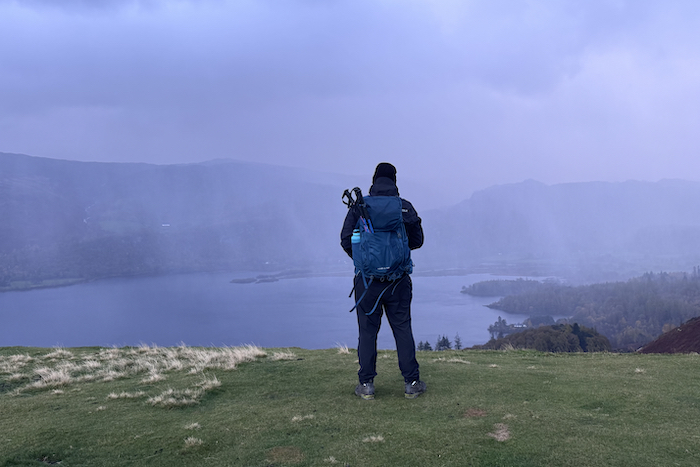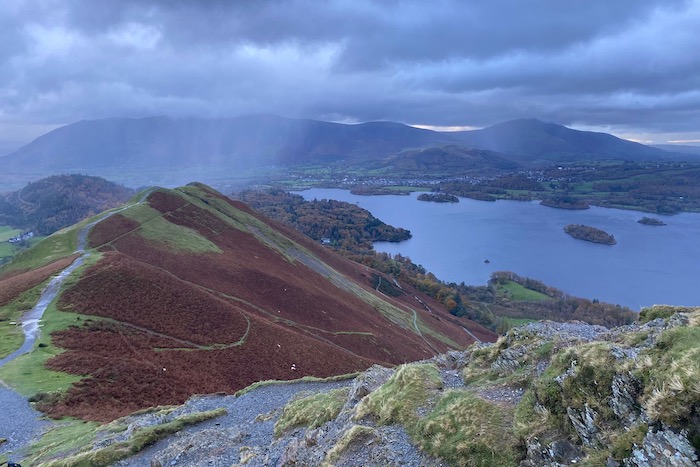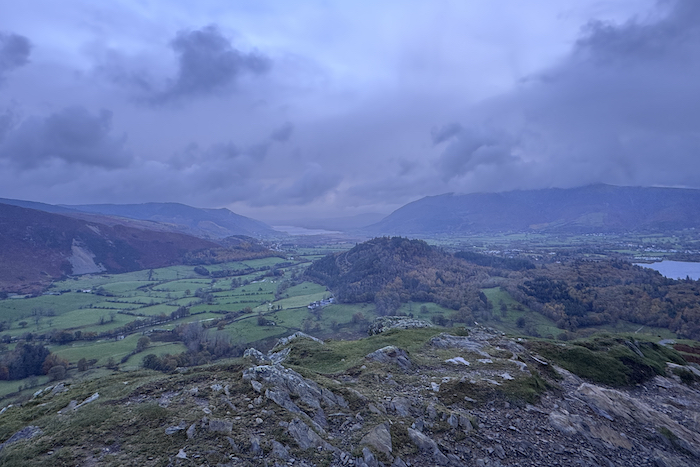Cat Bells: 6 mile circular

Moderate
3-3.5 hours
5.6 miles (9km)
The hike up Cat Bells might be short, but it’s one of the most loved walks in the Lake District — and for good reason. Rising gracefully above Derwentwater, this modest fell offers breathtaking views that rival many of the higher peaks such as Skiddaw and Blencathra. The route begins near Hawes End, climbing steadily along a well-trodden ridge with just enough rocky sections to feel adventurous, especially for families and first-time fell walkers.
Cat Bells is a brilliant choice for families — a true “mini mountain” that feels like an achievement without being overwhelming. Children will no doubt love the rocky bits near the top, and dogs will enjoy the open ridgeline (just take care near the steeper edges and on busy days) and ensure you take plenty of water for them, especially on warmer days.
The small car park fills up quickly and is in no way sufficient for the number of visitors Cat Bells draws in so ensure you arrive early to be in with a chance of grabbing a parking spot. Please be respectful of residents when parking and avoid blocking entrances and parking on double yellow lines — ticket enforcement is in force.
🌤️ Know Before You Go 🌤️
- Car Park: No fixed address (CA12 5UE) will get you close. On-road parking when car park is full
- What3Words: ///fended.porch.costly
- Public Transport:
- Elevation Gain: 467 metres
- Terrain: Steep, uneven rocky terrain. Slippery rock when wet and wet boggy sections.
- Public Toilets: No
- Family Friendly: Yes – not suitable for pushchairs
- Dog Friendly: Yes – Keep on lead and bring enough water, especially on warmer days
- Wainwrights: (1)
- Scramble Grade: Gentle non-technical scramble
- Other:
- Met Office Mountain Forecasts
- Mountain Weather Information Service (MWIS)
🥾 Essential Kit 🥾
- Good quality, well fitting walking boots/shoes
- 20-30L rucksack
- Gloves, hat, neck gaitor/snood
- Map, compass, and head torch (spare batteries)
- Emergency First Aid Kit (foil blanket, whistle, plasters)
- Additional layers of clothing
- Waterproof jacket and trousers
- At least 2 litres of water
- Hiking poles (optional)
❄️ Additional Winter Kit ❄️
- Hiking poles with ice fittings
- Waterproof hat and gloves
- Crampons/Ice Axe
- Dry bags
- Extra food and water
- Sun protection
- Emergency shelter such as a survival or bivi bag
- A more comprehensive First Aid Kit
Cat Bells 6 mile circular route description

Stage 1 – Hawes End to Cat Bells summit
The walks begins at the bus stop, follow the finger-post sign signaling ‘Cat Bells summit – 1 mile’ and keep left when the path forks. The path is rocky and uneven and there are stone step sections as you climb higher. There is a nice scramble near the memorial stone to Thomas Arthur Leonard. Continue ahead as you head over Skelgill Bank. This next section is relatively straight forward but you do need to take care and ensure 3-points of contact for safety especially in bad weather. For those with shorter legs (like Louise) you may need to use a knee to get up this section. After this there is one final climb to the summit of Cat Bells.
Stage 2 – Cat Bells summit back to Manesty Cottages and Glamping
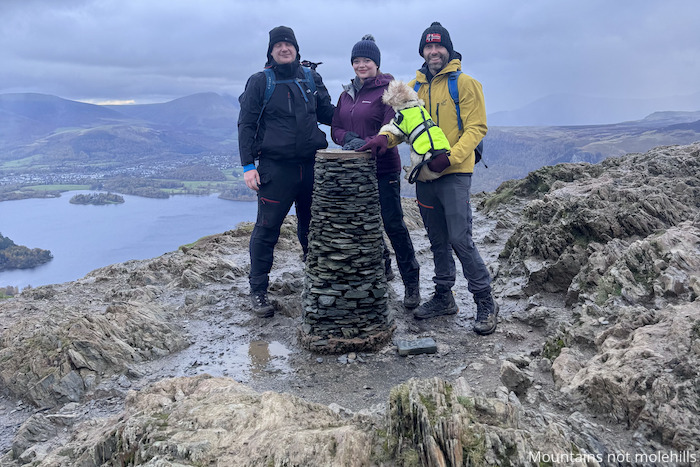
Continue on from the summit, there is a bit of a steep section to come down which can be tricky especially in bad weather. Follow the path along and when you reach approximately 1.8 miles (3km) there is a path down to the left. It zig zags a little bit and then descends with a mixture of rocky steps and lose gravel. There are several paths leading off to your left but just continue straight ahead. At the bottom of the path turn right onto the main road where Manesty Cottages and Glamping site is on your right side.
Stage 3 – Manesty Cottages and Glamping to Derwent Water
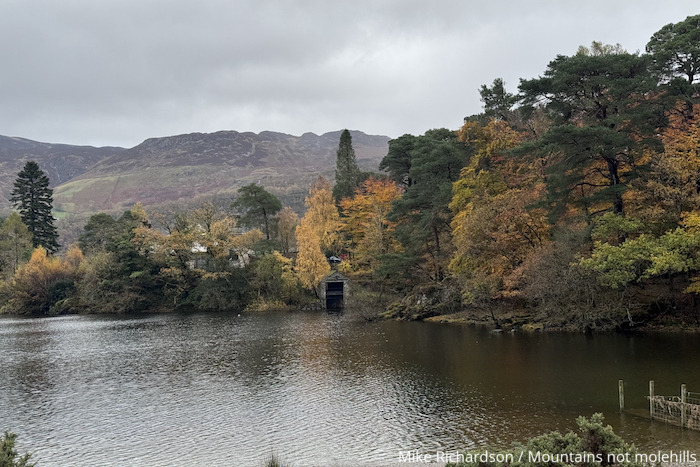
Walk a short distance down the main road until you reach a timber gate. Head through the gate and follow the stone path along through the farm land (this section can be wet and boggy). When you reach the gate, head through. There are a couple of paths here but they all pretty much end up in the same place. We took the path to the right, when you reach a point where the path splits into three directions turn left and follow the path all the way along the edge of Derwent Water. You pass by several bays and then follow the path slightly to the left. Go through the gate and continue along the path (be warned this area can flood so there will be a good chance of getting your feet wet). Further along take a left at the sign for Cat Bells. Follow the track along back to the start of the walk.
🧭 Safety information & Tips
Crowds: Cat Bells is extremely popular — go early or on a weekday for a quieter experience.
Slippery in Wet Weather: The short rocky scrambles near the top can be slick after rain; good footwear makes all the difference.
Wind Exposure: The ridge is open and breezy — take a windproof layer, especially for little ones.
Parking: The small lay-bys fill quickly; the Keswick Launch ferry to Hawes End is a great alternative.
Dogs: Keep dogs close on the ridge and near grazing livestock.
Where to eat and drink after hiking Cat Bells
There is no shortage of options for grabbing a drink following hiking Skiddaw mountain. Keswick town centre has an abundance of pubs and restaurants (there must be 35+ pubs). As you would expect the prices match that of a town reliant on tourism, however, for a cheaper option there is a Wetherspoons.
A relative new comer to the Keswick pub scene is The Crafty Baa — housed in a historic building dating back to the 19th century. Expect wines and spirits and an impressive selection of ciders, craft beers and local ales served in pints and two thirds. Whisky lovers will be happy to hear the venue has a selection of 93 world whiskies to choose from.



